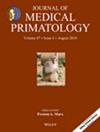橄榄狒狒(Papio anubis)的坑状角质溶解症
IF 0.5
4区 农林科学
Q3 VETERINARY SCIENCES
引用次数: 0
摘要
在一只橄榄狒狒(Papio anubis)身上,通过活组织切片检查确诊了人类的一种皮肤病--凹陷性角质溶解症,并且对局部治疗反应良好。人类的凹陷性角质溶解症是由角质层内过度生长的角质溶解细菌引起的。这是在非人灵长类动物中首次报道的病例。本文章由计算机程序翻译,如有差异,请以英文原文为准。
Pitted Keratolysis in an Olive Baboon (Papio anubis)
Pitted keratolysis, a dermatologic condition in humans, was diagnosed in an olive baboon (Papio anubis) via biopsy and responded well to topical treatment. In humans, pitted keratolysis is caused by the overgrowth of keratinolytic bacteria within the stratum corneum. This represents the first reported case in a nonhuman primate.
求助全文
通过发布文献求助,成功后即可免费获取论文全文。
去求助
来源期刊
CiteScore
1.40
自引率
42.90%
发文量
62
审稿时长
6 months
期刊介绍:
The Journal of Medical Primatology publishes research on non-human primates as models to study, prevent, and/or treat human diseases; subjects include veterinary medicine; morphology, physiology, reproductive biology, central nervous system, and cardiovascular diseases; husbandry, handling, experimental methodology, and management of non-human primate colonies and laboratories; non-human primate wildlife management; and behaviour and sociology as related to medical conditions and captive non-human primate needs.
Published material includes: Original Manuscripts - research results; Case Reports - scientific documentation of a single clinical study; Short Papers - case histories, methodologies, and techniques of particular interest; Letters to the Editor - opinions, controversies and sporadic scientific observations; Perspectives – opinion piece about existing research on a particular topic; Minireviews – a concise review of existing literature; Book Reviews by invitation; Special Issues containing selected papers from specialized meetings; and Editorials and memoriams authored by the Editor-in-Chief.

 求助内容:
求助内容: 应助结果提醒方式:
应助结果提醒方式:


